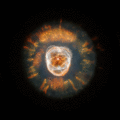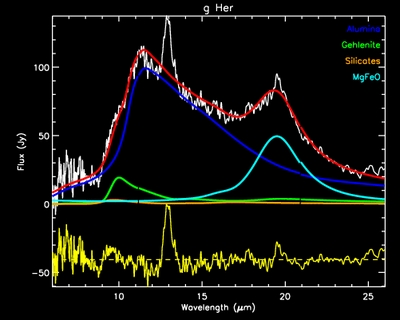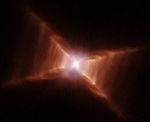Evolved Stars

A planetary nebula -- telltale signs of a dying star.
Our cosmic origins lie deep within the stellar interiors, where all of the heavy elements in the universe are created in the nuclear fusion processes that generates the star's energy. As more and more hydrogen is consumed, less and less fuel is available for energy production, and eventually the star's fuel supply will be exhausted. This will happen to our sun in about 5 billion years. Massive stars end their lives with a spectacular supernova explosion, but for less massive stars (such as the sun), the last phases of the star's life involve less dramatic events which often result in very picturesque settings such as Planetary Nebulae (PNe).
Such stars at first become Red Giants - stars that are about 250 times larger than the sun. In fact, when our sun has reached this stage, it might well become large enough for the sun's surface to reach the earth's orbit. These Red Giants start loosing their outer layers and dump them into the Interstellar Medium (ISM); slowly at first, but at an ever increasing rate until they have lost almost all of their initial mass and all that is left is a White Dwarf - the core of the star which is not much bigger than the earth. All the material that is lost in this phase is what can later light up and create the beautiful planetary nebulae.
In these Red Giant outflows, molecules and dust are formed containing all the freshly produced heavy elements. This will eventually be incorporated into the next generation of stars, planetary systems and their possible inhabitants - hence the popular catchphrase "We are made of stardust". However, it is not clear exactly how these Giants loose their mass, and what molecules and dust grains form at which parts in the outflow. So we are made of stardust, but we don't know exactly what the stardust is made of.

In my research on evolved stars, I analyze infared observations of evolved stars. These analyses include molecular spectroscopy and dust mineralogy - determining what minerals are present in these dusty outflows. For example, in this figure it can be clearly seen that the dust around the star g Her contains 3 known minerals (and probably some more minerals that are not identified yet). Note that those minerals are also found on earth - the alumina for instance (the blue curve) would on earth be called ruby or sapphire.

The Red Rectangle (HST image by H. van Winckel, M. Cohen, H. Bond and T. gull)
I am also interested in a set of peculiar evolved stars of which the Red Rectangle (right) is probably the most known one. These stars are what I refer to as WEIRDOs (Wonderfully Enigmatic, Intriguing and Remarkably Different Objects) since each new observation that appears of these objects is totally opposite to what one would expect. They are all eccentric close binary stars of which one component is an evolved star. They show the weirdest surface abundance patterns, have a massive disk surrounding the entire binary system, and in this disk the dust and gas composition is completely unlike any other evolved star we've seen. Again, the use of infrared spectroscopy on these objects has increaseed the list of oddities for these objects. The Red Rectangle is also known to show emission features that seem to correspond to some of the Diffuse Interstellar Bands (DIBs).


